 ?Mathematical formulae have been encoded as MathML and are displayed in this HTML version using MathJax in order to improve their display. Uncheck the box to turn MathJax off. This feature requires Javascript. Click on a formula to zoom.
?Mathematical formulae have been encoded as MathML and are displayed in this HTML version using MathJax in order to improve their display. Uncheck the box to turn MathJax off. This feature requires Javascript. Click on a formula to zoom.Abstract
We present laboratory measurements of angular light scattering intensity for aerosolized, micron-sized, irregularly shaped aluminum oxide (Al2O3) abrasive powders with different grit sizes. The measurements were carried out with the scattering angle ranging from 0.32° to 177.6°. First, we demonstrate that the light scattering inferred diameters were in good agreement with the intensity-weighted mean sizes and discuss the importance of intensity-weighted size distributions. Second, the wide range of scattering angles motivated us to visualize the same scattering intensity data with three methods: (a) logarithmically versus linear scattering angle θ, (b) logarithmically versus the logarithmic magnitude of the scattering wave vector q for forward scattering, the method of Q − space analysis, and (c) logarithmically (last ≈ 20 degrees of θ) versus linear phase angle (180° - θ). The combination of these viewpoints yields a comprehensive description of the scattering that corresponds to dividing angular scattering into three regimes: forward−, side–, and back − scattering. The light scattering measurements were compared to the Mie scattering calculated for homogenous, spherical particles with the same volume-equivalent size distribution as that of the Al2O3 particles determined with an aerodynamic particle sizer. Experimental and Mie-theory results were well-matched in the forward regime which is clearly shown in Q − space but showed a poor matching in the side and backscattering regimes, as displayed in θ− and (180°- θ) space, respectively.
EDITOR:
1. Introduction
Understanding the optical properties of mineral dust particles is essential in many fields of science, technology, and environmental studies. It has been observed that atmospherically available dust particles affect the climate forcing through the direct scattering and absorption of solar radiation (Kok et al. Citation2023). So, it is imperative to understand the interaction of dust particles with light. The optical properties of spherical particles can easily be calculated (Mie Citation1908) leading to improved understanding (Sorensen et al. Citation2019; Moosmüller and Sorensen Citation2018b, Citation2018a; Berg et al. Citation2005; Sorensen and Shi Citation2002). However, mineral dust particles are irregular in shape (Engelbrecht et al. Citation2016) and their interaction with light can be challenging to calculate (especially for inhomogeneous particles) and is not yet well understood. However, with the improved availability of algorithms, codes, and computing hardware, the interaction of light with non-spherical particles can be calculated for known particle refractive index and morphology with some limitations for large particles (Mishchenko et al. Citation1997). Nevertheless, light scattering from complex and irregular particles with diverse sizes is still not well understood theoretically, partly due to a lack of appropriate morphology models (Zubko et al. Citation2013) and complex refractive indices (Moosmüller Citation2023).
In the work described here, we present measurements of light scattering from complex and irregular aluminum oxide (Al2O3) abrasive particles with diverse sizes. Al2O3 is birefringent having refractive indices of 1.760 and 1.768 (Palik Citation1998) at the studied wavelength λ = 532 nm but we used the refractive index as 1.76 for Mie calculations. The aluminum oxide particles used here are representative of irregular particles with a refractive index similar to or somewhat larger than that of atmospheric mineral dust particles (Castellanos et al. Citation2024). Our work investigates how well Mie theory describes experimentally measured wide-angle scattering data, covering the range from near forward at scattering angle θ = 0.32° to nearly exactly backscattering at θ = 177.6°, for irregular particles. This covers significantly more of the near forward and near backward angular range than, for example, polar nephelometers (Dolgos and Martins Citation2014). With this wide angular range, we have found it useful to divide the whole angular scattering range into three regimes: forward−, side−, and back − scattering. Mie theory works well for the irregular particles studied here in the forward range, but characteristic deviations are found and described in the side and backscattering ranges. We also applied Guinier analysis to the forward scattering data and demonstrate the consistency of the size inferred by light scattering analysis with intensity-weighted number size distribution measured by an aerodynamic particle sizer (APS) (Peters et al. Citation2006; Baron Citation1986).
2. Materials and methods
We performed the light scattering experiments on aluminum oxide abrasive (Al2O3) particles of varying size distributions that were acquired from Panadyne Inc. (Montgomeryville, PA, USA). One of us studied these particles previously with a different perspective (Gautam Citation2022; Heinson et al. Citation2016a). The manufacturer specified the particle size distribution as 1200, 1000, 800, and 600 grits, where a higher number indicates finer particles (Linke Citation2015; Orvis and Grissino-Mayer Citation2002). Optical microscope images of these particles for 1200, 1000, 800, and 600 grits are shown in , respectively. These particles were generated using abrasive action such that the particles undergo rolling between the two grinding surfaces, resulting in moderately irregular particles (see ), unlike particles with very irregularly complex shapes. Thus, our particles may be ideal for comparing scattering patterns between spherical and somewhat irregular particles such as those encountered in mineral dust (Castellanos et al. Citation2024; Engelbrecht et al. Citation2016).
Figure 1. Optical microscope images of aluminum oxide (Al2O3) abrasive grits at different size distributions: (a) 1200, (b) 1000, (c) 800, and (d) 600 grit (Heinson et al. Citation2016a).
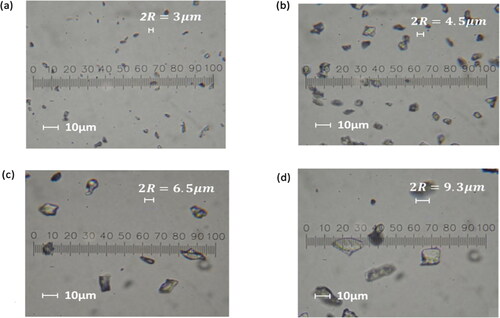
The experimental setup and data procurement methods used can be found in Gautam and Sorensen (Citation2021) and are briefly summarized here: the apparatus covers the scattering angle range, 0.32° ≤ θ ≤ 177.6°, and correspondingly scattering wave vectors ranging from 660 cm−1 to 2.36 × 105 cm−1, see EquationEquation (2)(2)
(2) , below. The light source used for our experiment is a vertically polarized green laser (Coherent 532 nm CW DPSS Sapphire) with a wavelength λ = 532 nm and a beam diameter of 0.7 mm (1/e2 power) (Moosmüller and She Citation1991). The laser light interacts with an upward, vertical aerosol flow from the aerosol tube with an inner diameter of 3 mm, forming a cylindrical-shaped scattering volume with dimensions of 3 mm × 0.7 mm. The scattered light from the scattering volume was measured with two multi-channel detectors simultaneously, resulting in data at 46 angles. The experimental setup can be divided into three different sections, namely forward−, side−, and back − scattering setups.
Given the wide scattering angle range (i.e., 0.32° − 177.6°), our setup separately but simultaneously images forward-, side-, and back-scattering onto three linear multi-channel detectors, which also corresponds to our visualization and interpretation for these three regimes. We focus on the comparison of experimental data with results of Mie-theory calculations.
Mie calculations were carried out using number size distributions, measured with an aerodynamic particle sizer (TSI APS 3321), as input. The APS aerodynamic diameter (Da) was converted to the volume equivalent diameter (Dv), as required for the Mie calculations, using (Curtis et al. Citation2008; Hinds Citation1982),
(1)
(1)
where
is the unit density,
is the particle density, and
is the aerodynamic shape factor of the particle. The aerodynamic shape factor is the ratio of drag force acting on a non-spherical particle to that of a spherical particle having the same volume and velocity (Fuchs Citation1964). The shape factor indicates the irregularity in the particle shape (for a sphere,
= 1).
To analyze wide angular range light scattering data, we plot the same data (a) logarithmically versus linear scattering angle θ, (b) logarithmically versus the logarithmic magnitude of the scattering wave vector q for forward scattering, and (c) logarithmically (last ≈ 20 degrees of θ) versus linear phase angle (180° - θ). The scattering wave vector q (cm−1) is given by the relation
(2)
(2)
where k = 2π/λ, with λ being the wavelength of the light, and θ is the scattering angle. The log-log plotting of scattered intensity versus q is called “Q − space analysis” (Sorensen Citation2013, Citation2022). This triple analysis of our data yields a comprehensive description of the scattering that neither individual plot can give (Gautam and Sorensen Citation2021). Q − space plots also facilitate the Guinier analysis of forward scattering data that yields a light scattering weighted effective size to a good approximation (Gautam and Sorensen Citation2020; Gautam et al. Citation2020), and as we will see below.
3. Results
3.1. A Comparison of sizes estimated from light scattering with intensity − weighted sizes from APS
The application of Guinier analysis to our scattering data enables the determination of the radius of gyration () for a particle of arbitrary shape, without knowledge of the particle refractive index. We plot the light scattering data in Q − space, where one can directly apply Guinier analysis to determine the size of any arbitrarily shaped particles, under the assumption of weak refractivity (Sorensen and Shi Citation2000). The Guinier equation is
(3)
(3)
where I(q) is the scattering intensity, I (0) is the forward scattering intensity,
is the particle radius of gyration, and q is the magnitude of the scattering wave vector. EquationEquation (3)
(3)
(3) is satisfied when the internal coupling parameter
approaches zero. The internal coupling parameter
for a sphere is given by Heinson et al. (Citation2015) as
(4)
(4)
where R is the effective radius or volume equivalent radius,
is the particles complex refractive index, and the wavevector
is defined as 2π/λ, with λ denoting the wavelength. The internal coupling parameter is similar to the phase shift parameter (Bohren and Huffman Citation1983) but has superior ability to organize the scattering from particles, including determination of the asymptotic regimes and diffraction limit for light scattering from spheres (Sorensen Citation2022; Heinson et al. Citation2015, Citation2016b). For small
EquationEquation (3)
(3)
(3) can be written as
(5)
(5)
The size determined from the Guinier analysis is accurate only in the diffraction limit when the internal coupling parameter < 1, i.e., for weakly refractive particles. For
> 1, the Guinier equation still holds but the radius of gyration given by EquationEquation (5)
(5)
(5) is not the true radius of gyration. For a sphere with
≫ 1, the ratio of the true to measured radii of gyrations is 0.85 ± 0.04 (Y. Wang et al. Citation2015; Sorensen and Shi Citation2000). Taking these caveats into account, we applied Guinier analysis to aluminum oxide abrasive particles to obtain light scattering inferred sizes.
shows the results of applying Guinier analysis to our scattering data for aluminum oxide particles. The data are minimal because large particles, such as ours, have Guinier regimes limited to very small angles. With this caveat and the philosophy that having some data is better than having no data, we proceed. EquationEquation (5)(5)
(5) indicates that the Guinier plot should be a straight line with slope Rg2/3, encompassing the sizes of the particles. For the 1200 and 1000 grits, multiple data points satisfy the condition
< 1, whereas for the 800 and 600 grits, we only have limited data points, resulting in poorly defined Guinier inferred sizes. According to the linear regression slopes, the Guinier inferred radii of gyrations for 1200, 1000, 800, and 600 grits were found to be
= 2.1, 3.6, 6.6, and 8.3 µm, respectively. After applying the correction factor of 0.85 (Y. Wang et al. Citation2015; Sorensen and Shi Citation2000), the Guinier inferred radii of gyration were calculated to be 1.8, 3.1, 5.6, and 7.1 µm, respectively. Despite the irregularity in particle shape, we made an approximation based on a sphere such that
=
R (Sorensen and Shi Citation2000). Thus, the equivalent sphere radii for 1200, 1000, 800, and 600 grits were found to be 2.4, 3.9, 7.2, and 9.1 µm with corresponding sphere diameters of 4.7, 7.9, 14, and 18 µm, respectively.
Figure 2. Guinier analysis of scattering data for aluminum oxide (Al2O3) abrasive particles of 1200, 1000, 800, and 600 grit.
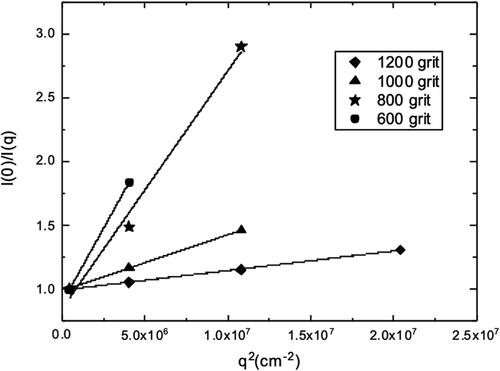
We used an aerodynamic particle sizer (APS 3321) to measure the particle size distribution in terms of aerodynamic diameter, which was converted to volume equivalent diameters using EquationEquation (1)(1)
(1) . The aluminum oxide (Al2O3) abrasive particles exhibit a moderately irregular, near spherical shape, as illustrated in , unlike strongly irregular illite particles which have a shape factor
= 1.3 (Hudson et al. Citation2008). With this value of
(square root dependence) in EquationEquation (1)
(1)
(1) , the magnitude of Dv changed by 14%. Upon comparing the shapes of our Al2O3 particles with those of illite particles, our particles are much more spherical and therefore have a shape factor
closer to unity. Thus, any uncertainties in the
value would result in a negligible change of the volume equivalent diameter (Dv).
APS observed most probable volume equivalent particle diameters (after applying EquationEquation (1)(1)
(1) ) for 1200, 1000, 800, and 600 grits were found to be 2.7, 6.0, 7.8, and 10 µm (). These are in general agreement with the average sizes in diameters provided by the manufacturer, 3 ± 0.5, 4.5 ± 0.8, 6.5 ± 1.0, and 9.3 ± 1.0 µm, respectively. These measurements were in poor agreement with the diameters obtained from Guinier analysis of measured light scattering data. The Guinier inferred volume equivalent sphere diameters, indicated by vertical lines, were 4.7, 7.9, 14, and 18 µm for 1200, 1000, 800, and 600 grits, respectively. However, one must realize that the light scattering intensity depends on the size of particles such that larger particles contribute more to the light scattering than the smaller particles. Since the Guinier regime lies in the forward scattering regime, the scattering intensity in this regime is proportional to the diameter to the fourth power, i.e., D4. To account for this, we multiplied the volume equivalent number size distribution by their corresponding D4. shows the volume equivalent numbers size distribution and their transformed intensity weighted distributions for four different grits 1200, 1000, 800, and 600. We normalized both the number size distribution and corresponding converted intensity weighted distribution to have a peak value of unity. Intensity weighted distribution curve showed that even though most particles lie in the smaller size range, the contribution by those particles is negligible when compared to the larger particles’ contributions. The intensity-weighted distribution for 1200, 1000, 800, and 600 grits showed a peak around the diameters of 4.5, 7.5, 14, and 17 µm, respectively. These peaks were consistent with the Guinier inferred diameters, i.e., light scattering determined diameters. However, a larger discrepancy was seen for 600 − grit particles () which may be explained by the poorly defined Guinier inferred size, that only has two data points satisfying the condition,
< 1 for Guinier analysis.
Figure 3. Particle number size distribution for aluminum oxide (Al2O3) abrasive particles of various grit sizes (a) 1200, (b) 1000, (c) 800, and (d) 600, measured with the APS 3321 after converting aerodynamic diameter Da to the volume equivalent diameter and their transformation to an intensity weighted distribution with a weighing factor of D4. The vertical line in each graph indicates Guinier inferred volume equivalent sphere diameters.
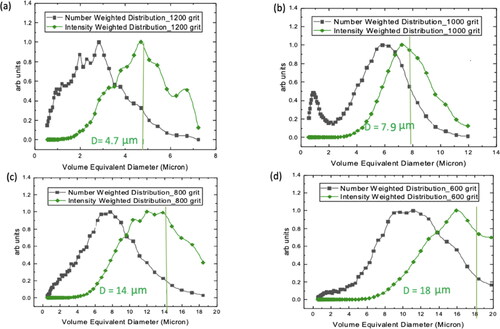
To summarize, the most important point here is that light scattering combined with Guinier analysis is successful in determining the heavily weighted, most probable size of a light scattering-weighted particle size distribution. A corollary to this conclusion is that the most probable sizes of a size distribution as determined by light scattering methods are in agreement with APS results when the effects of intensity weighting are accounted for.
3.2. Comparison of light scattering data with Mie calculations using APS observed number size distributions
Upon a thorough review of previously published studies on light scattering using both θ − and Q − space analyses, we argue that the most effective way to achieve a comprehensive explanation of wide − angle light scattering data is dividing the whole angular scattering range into three regimes namely: forward-, side-, and back-scattering.
The forward-scattering regime consists of a constant forward scattering lobe (q and θ independent), when
< 1, and ends in the Guinier regime near
1 (θ
where R is the effective radius of the particle. This regime can be classified as a diffraction-dominated regime (Sorensen Citation2013, Citation2022; Maughan Citation2020).
The side-scattering regime contains a cross-over from diffraction to refraction-dominated. This regime contains the refraction hump, which is most readily apparent in Q-space. Sometimes power laws of limited range appear in this regime, especially for fractal-like aggregates. Spheres can show complex and near singular scattering like rainbows (Sorensen Citation2013, Citation2022; Maughan Citation2020).
The back-scattering regime is where an enhancement in scattering relative to the side-scattering can occur. Spheres can show the glory in this regime (Sorensen et al. Citation2017; Nussenzveig Citation2012).
Descriptions 2 and 3 apply for non-absorptive particles along with absorptive particles that satisfy the condition, < 3, where κ is the imaginary part of the particle refractive index and
the size parameter (Gautam and Sorensen Citation2020; Maughan and Sorensen Citation2020; G. Wang et al. Citation2015). They also apply best to non-spherical particles which typically do not have the very complex behavior in regimes 2 and 3 that spheres have. However, a size distribution commonly conceals the complex light-scattering patterns of the sphere, thereby validating the descriptions in regimes 2 and 3.
and illustrate angular scattering from various perspectives, i.e., θ− and Q − space, as well as phase angle (180°- θ) analysis for the comparison between the experimentally measured light scattering results and Mie calculations. Mie calculations were carried out for volume equivalent number size distributions obtained from APS observed number size distributions. For these comparisons, the data were normalized to have a unity value at the scattering angle of 0.32°, the smallest angle at which we measured scattering intensity. Across all the sizes, the Q-space plot shows a constant forward scattering lobe at the smallest q, followed by a Guinier regime around q R−1. This is followed by a power law that ends around a q ≈ 2 × 105 cm−1. For q ≳2 × 105 cm−1, the scattering intensity starts to increase with increasing q, corresponding to an enhancement in the backscattering. Note that Al2O3 particles are non-absorptive, thereby leading to an enhancement in the backscattering (G. Wang et al. Citation2015).
Figure 4. Comparison of the experimentally observed forward normalized light scattering data with Mie calculations for APS observed aluminum oxide abrasive particles. Upper row (1200 grit): the same data were plotted both (a) logarithmically versus linear scattering angle (θ) (left), (b) logarithmically versus logarithmic q (middle), and (c) logarithmic backscattering as a function of linear phase angle (180° - θ) (right). Lower row (1000 grit): the same data were plotted both (d) logarithmically versus linear scattering angle (θ) (left), (e) logarithmically versus logarithmic q (middle), and (f) logarithmic backscattering (last ≈ 20 degrees) as a function of linear phase angle (180° - θ).
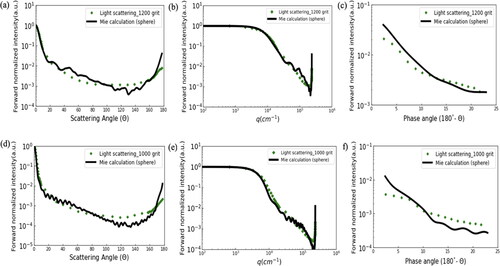
Figure 5. Comparison of the experimentally observed forward normalized light scattering data with Mie calculations for APS observed aluminum oxide abrasive particles. Upper row (1200 grit): the same data were plotted both (a) logarithmically versus linear scattering angle (θ) (left), (b) logarithmically versus logarithmic q (middle), and (c) logarithmic backscattering as a function of linear phase angle (180° - θ) (right). Lower row (1000 grit): the same data were plotted both (d) logarithmically versus linear scattering angle (θ) (left), (e) logarithmically versus logarithmic q (middle), and (f) logarithmic backscattering (last ≈ 20 degrees) as a function of linear phase angle (180° - θ).
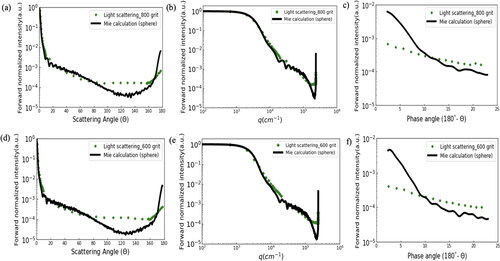
For all aluminum oxide abrasive grits, results of Mie calculations matched well with our experimental results for the forward-scattering regime, and semi-quantitatively for the side-, but poorly for the back-scattering regime. The close matching for the forward scattering regime is expected because this regime is diffraction dominated and diffraction is fairly insensitive to shape and the refractive index of particles, while being strongly dependent on q. Of course, Mie theory is a theory concerning electromagnetic waves, hence it contains diffraction.
Mie theory’s tendency to differ from experimental values at the side and the backscattering regimes are well-known and consistent with previous results (e.g., Jaggard et al. Citation1981; Perry et al. Citation1978; Zerull et al. Citation1977). These results also show that the difference becomes more pronounced as particle size becomes larger, like the increase in discrepancy seen in our results as size increased from 1200 to 600 grits. Furthermore, Wiscombe and Mugnai (Citation1986) found that the smooth and featureless scattering is greatest in the angular region, 80° − 150°. However, our observations show this featureless smooth scattering pattern starts from ≈ 80° up to 140° (1200 grit) and extends further to 160° (600 grit). Bohren and Singham (Citation1991) explained that the smooth and featureless side scattering is due to the particle ensembles being a mixture of different shapes, leading to the averaging out of shape-specific details of individual particle phase functions. This result is further corroborated by computational results obtained from T − matrix calculations for a mixture of polydisperse, randomly oriented spheroids (Mishchenko et al. Citation1997). For all our grit sizes, there is an enhancement in the backscattering at the end of this smooth and featureless scattering, but this enhancement seems to decrease with increasing particle size. Similar findings were reported by Muñoz et al. (Citation2021) for forsterite particles of various sizes. The largest particles exhibited a flattened behavior, and the enhancement in the backscattering increased as they approached the Rayleigh scattering regime for smallest size category (Muñoz et al. Citation2021).
Additionally, in and , the theoretical Mie calculations demonstrate a strong refraction hump and large, enhanced backscattering for all particle size distributions. As the particle sizes increase, there is a noticeable rise in the amplitude of the refraction hump. However, the light scattering results show at most a weak or no refraction hump for all grit sizes. The absence of a refraction hump for our light scattering results can be attributed to the scattering from an ensemble of irregular particles. We propose that the unique orientation of each particle in the ensembles results in averaging out the individual shape-specific scattering, eliminating the refraction hump. Moreover, in and , the Mie calculations show higher scattering intensity at near exact backscattering angles and smaller one at near 130°, corresponding to q ≈ 2 × 105 for all grit sizes.
3.3. Comparison between light scattering from spherical particles to that from irregular particles of similar size
Additional experiments were carried out to further demonstrate and understand the discrepancies between Mie theory calculations and experimental results seen for the side-scattering and back-scattering regimes ( and ). We scattered light from spherical particles (, left) and irregular particles (, right) of roughly equivalent sizes, i.e., ≈ 5 and 4.5 µm diameter, respectively. Again, the light scattering results were plotted both in θ−, and Q − space, and phase angle (180° - θ) for last ≈ 20 degrees. This is shown in , respectively, with normalization at the smallest used scattering angle of 0.32°. The matched forward scattering result is consistent with the results shown in and , demonstrating that the forward scattering regime is fairly insensitive to particle non-sphericity. However, for the side and backscattering regimes, the measured scattering intensity differs, corroborating our observations above. These results further demonstrate a tendency of irregular particles to display smooth and featureless side − and back − scattering including a lesser enhancement at near and at exact backscattering angles, compared to spherical particles. Finally, the cross-over is observed at a larger phase angle, approximately at ≈ 22° in (seen clearly in ), phase angle (180° - θ) analysis. This differs from the results in and , where the cross-over is located at ≈ 10° − 15°. The potential cause of this distinction may lie in the imperfect spherical nature of the particles, as depicted in (left). Note that in and , we compared the light scattering data obtained from irregular particles with the Mie calculations that assume a perfectly spherical particle shape.
Figure 6. Comparison of experimentally measured light scattering data for spherical to irregular particles of equivalent size: 5 and 4.5 µm diameter, respectively. The same data were plotted (a) in θ − space and (b) in Q − space, (c) the backscattering data (last ≈ 20 degrees) as a function of phase angle (180° - θ), and (d) Transmission Electron Microscope (TEM) image of our spherical particles (left) and optical microscopy image of our irregular particles (right).
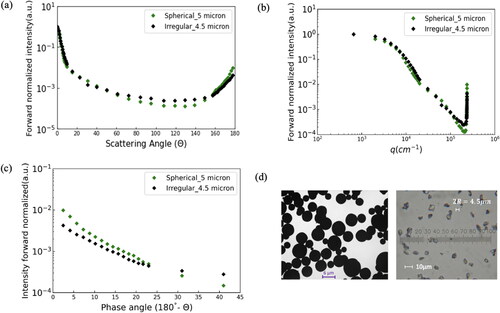
4. Conclusions
We have demonstrated that Guinier analysis of light scattering from an ensemble of particles yields a measurement of the intensity weighted most probable size consistent with size analysis using an aerodynamic particle sizer (APS). We remark that Guinier analysis originates from Small Angle X-ray Scattering (SAXS). The refractive index for most materials in the X-ray regime is near unity, and this is a condition for the derivation of the Guinier equation. Thus, our demonstration of the veracity of Guinier analysis for refractive particles is new and broadens the application of Guinier analysis.
We have also demonstrated the facility of viewing the angular dependence of light scattering from particles into three regimes: forward−, side − and back − scattering. This point of view was facilitated by the wide angular range of our data and graphing the scattered intensity in both θ − space (as usually done) and Q − space. We found that Mie theory for spherical particles aligns well with our experimental data for irregular particles in the forward scattering regime, but significant discrepancies arise in the side − and back − scattering regimes. In addition, we showed that the application of Mie theory to analyze the side − and back − scattering data for atmospherically important irregular aerosol particles, such as entrained mineral dust, may result in significant errors that currently are often ignored.
This work has applications for backscattering instrumentation such as elastic back − scatter lidars (Ceolato and Berg Citation2021; Winker et al. Citation2010) and the EPIC (Earth Polychromatic Imaging Camera) instrument onboard NOAA’s DSCOVR (Deep Space Climate Observatory) located at the Earth-Sun Lagrange-1 (L-1) point observing aerosol backscattering from the sunlit earth hemisphere (Marshak et al. Citation2022; Valero et al. Citation2021). Overall, our results are important for the optical characterization of particles in the fields of atmospheric science and astronomy.
Disclosure statement
No potential conflict of interest was reported by the author(s).
Additional information
Funding
References
- Baron, P. A. 1986. Calibration and use of the aerodynamic particle sizer (APS 3300). Aerosol Sci. Technol. 5 (1):55–67. doi: 10.1080/02786828608959076.
- Berg, M. J., C. M. Sorensen, and A. Chakrabarti. 2005. Patterns in Mie scattering: evolution when normalized by the Rayleigh cross section. Appl. Opt. 44 (34):7487–93. doi: 10.1364/AO.44.007487.
- Bohren, C. F., and D. R. Huffman. 1983. Absorption and Scattering of Light by Small Particles. Wiley, New York.
- Bohren, C. F., and S. B. Singham. 1991. Backscattering by nonspherical particles: a review of methods and suggested new approaches. J. Geophys. Res. 96 (D3):5269–77. doi: 10.1029/90JD01138.
- Castellanos, P., P. Colarco, W. R. Espinosa, S. D. Guzewich, R. C. Levy, R. L. Miller, M. Chin, R. A. Kahn, O. Kemppinen, H. Moosmüller, et al. 2024. Mineral dust optical properties for remote sensing and global modeling: a review. Remote Sens. Environ. 303:113982. doi: 10.1016/j.rse.2023.113982.
- Ceolato, R., and M. J. Berg. 2021. Aerosol light extinction and backscattering: a review with a lidar perspective. J. Quant. Spectrosc. Radiat. Transf. 262:107492. doi: 10.1016/j.jqsrt.2020.107492.
- Curtis, D. B., B. Meland, M. Aycibin, N. P. Arnold, V. H. Grassian, M. A. Young, and P. D. Kleiber. 2008. A laboratory investigation of light scattering from representative components of mineral dust aerosol at a wavelength of 550 nm. J. Geophys. Res. 113 (D8). doi: 10.1029/2007JD009387.
- Dolgos, G., and J. V. Martins. 2014. Polarized Imaging Nephelometer for in situ airborne measurements of aerosol light scattering. Opt. Express. 22 (18):21972–90. doi: 10.1364/OE.22.021972.
- Engelbrecht, J. P., H. Moosmüller, S. Pincock, R. M. Jayanty, T. Lersch, and G. Casuccio. 2016. Technical Note: mineralogical, chemical, morphological, and optical interrelationships of mineral dust re-suspensions. Atmos. Chem. Phys. 16 (17):10809–30., 2016. doi: 10.5194/acp-16-10809-2016.
- Fuchs, N. A. 1964. The Mechanics of Aerosols, Revised & enlarged edition. ed. Pergamon Press.
- Gautam, P. 2022. Light scattering study of irregular particles with arbitrary size, shape, and complex refractive index., (PhD Thesis)., Kansas State University. https://krex.k-state.edu/handle/2097/42344.
- Gautam, P., J. B. Maughan, J. Ilavsky, and C. M. Sorensen. 2020. Light scattering study of highly absorptive, non-fractal, hematite aggregates. J. Quant. Spectrosc. Radiat. Transf. 246:106919. doi: 10.1016/j.jqsrt.2020.106919.
- Gautam, P., and C. M. Sorensen. 2021. A wide range (0.32°–177.6°), multi-angle light scattering setup and concomitant analysis method. Rev. Sci. Instrum. 92 (11):113105. doi: 10.1063/5.0068318.
- Gautam, P., and C. M. Sorensen. 2020. A light-scattering study of highly refractive, irregularly shaped MoS2 particles. J. Quant. Spectrosc. Radiat. Transf. 242:106757. doi: 10.1016/j.jqsrt.2019.106757.
- Heinson, W. R., A. Chakrabarti, and C. M. Sorensen. 2015. A new parameter to describe light scattering by an arbitrary sphere. Opt. Commun. 356:612–5. doi: 10.1016/j.optcom.2015.08.067.
- Heinson, Y. W., A. Chakrabarti, and C. M. Sorensen. 2016a. A light-scattering study of Al2O3 abrasives of various grit sizes. J. Quant. Spectrosc. Radiat. Transf. 180:84–91. doi: 10.1016/j.jqsrt.2016.04.017.
- Heinson, Y. W., J. B. Maughan, W. R. Heinson, A. Chakrabarti, and C. M. Sorensen. 2016b. Light scattering Q-space analysis of irregularly shaped particles. JGR. Atmospheres 121 (2):682–91. doi: 10.1002/2015JD024171.
- Hinds, W. C. 1982. Aerosol technology: properties, behavior, and measurement of airborne particles, New York: A Wiley-Interscience publication.
- Hudson, P. K., E. R. Gibson, M. A. Young, P. D. Kleiber, and V. H. Grassian. 2008. Coupled infrared extinction and size distribution measurements for several clay components of mineral dust aerosol. J. Geophys. Res. 113 (D1). doi: 10.1029/2007JD008791.
- Jaggard, D. L., C. Hill, R. W. Shorthill, D. Stuart, M. Glantz, F. Rosswog, B. Taggart, and S. Hammond. 1981. Light scattering from particles of regular and irregular shape. Atmospheric Environment (1967), Plumes and Visibility Measurements and Model Components-Supplement 15 (12):2511–9. doi: 10.1016/0004-6981(81)90066-4.
- Kok, J. F., T. Storelvmo, V. A. Karydis, A. A. Adebiyi, N. M. Mahowald, A. T. Evan, C. He, and D. M. Leung. 2023. Mineral dust aerosol impacts on global climate and climate change. Nat. Rev. Earth Environ. 4 (2):71–86. doi: 10.1038/s43017-022-00379-5.
- Linke, B. S. 2015. A review on properties of abrasive grits and grit selection. IJAT. 7 (1):46. doi: 10.1504/lJAT.2015.070582.
- Marshak, A., A. Lyapustin, G. L. Schuster, A. Szabo, and R. Eckman. 2022. Editorial: DSCOVR EPIC/NISTAR: 5 years of observing earth from the first lagrangian point. Front. Remote Sens. 3. doi: 10.3389/frsen.2022.963660.
- Maughan, J. B. 2020. Q-space analysis of the orientationally averaged light scattering by particles of various shapes. PhD diss. Kansas State University. https://krex.k-state.edu/handle/2097/40898.
- Maughan, J. B., and C. M. Sorensen. 2020. Universal parameter to describe the reduction of refraction effects in the scattering of absorbing spheres. J. Opt. Soc. Am. A Opt. Image Sci. Vis. 37 (9):1456–64. doi: 10.1364/JOSAA.394401.
- Mie, G. 1908. Beiträge zur Optik trüber Medien, speziell kolloidaler Metallösungen. Ann. Phys. 330 (3):377–445. doi: 10.1002/andp.19083300302.
- Mishchenko, M. I., L. D. Travis, R. A. Kahn, and R. A. West. 1997. Modeling phase functions for dustlike tropospheric aerosols using a shape mixture of randomly oriented polydisperse spheroids. J. Geophys. Res. 102 (D14):16831–47. doi: 10.1029/96JD02110.
- Moosmüller, H. 2023. Chapter 16 - Optical properties of nonspherical, light-absorbing particles: Black carbon and mineral dust aerosols. In Light, Plasmonics and Particles, Nanophotonics, eds. M. P. Mengüç and M. Francoeur, 349–69. Amsterdam, Netherlands: Elsevier.
- Moosmüller, H., and C.-Y. She. 1991. Equal intensity and phase contours in focused Gaussian laser beams. IEEE J. Quantum Electron. 27 (4):869–74. doi: 10.1109/3.83316.
- Moosmüller, H., and C. M. Sorensen. 2018a. Single scattering albedo of homogeneous, spherical particles in the transition regime. J. Quant. Spectrosc. Radiat. Transf. 219:333–8. doi: 10.1016/j.jqsrt.2018.08.015.
- Moosmüller, H., and C. M. Sorensen. 2018b. Small and large particle limits of single scattering albedo for homogeneous, spherical particles. J. Quant. Spectrosc. Radiat. Transf. 204:250–5. doi: 10.1016/j.jqsrt.2017.09.029.
- Muñoz, O., E. Frattin, T. Jardiel, J. C. Gómez-Martín, F. Moreno, J. L. Ramos, D. Guirado, M. Peiteado, A. C. Caballero, J. Milli, et al. 2021. Retrieving dust grain sizes from photopolarimetry: An experimental approach. ApJS. 256 (1):17. doi: 10.3847/1538-4365/ac0efa.
- Nussenzveig, H. M. 2012. The Science of the glory. Sci. Am. 306 (1):68–73. http://www.jstor.org/stable/26014160. doi: 10.1038/scientificamerican0112-68.
- Orvis, K. H., and H. D. Grissino-Mayer. 2002. S Standardizing the reporting of abrasive papers used to surface tree-ring samples. Tree Ring Research 58 (1/2):47–50.
- Palik, E. D. 1998. Handbook of Optical Constants of Solids. San Diego, CA: Academic Press.
- Perry, R. J., A. J. Hunt, and D. R. Huffman. 1978. Experimental determinations of Mueller scattering matrices for nonspherical particles. Appl. Opt. 17 (17):2700–10. doi: 10.1364/AO.17.002700.
- Peters, T. M., D. Ott, and P. T. O'Shaughnessy. 2006. Comparison of the Grimm 1.108 and 1.109 portable aerosol spectrometer to the TSI 3321 aerodynamic particle sizer for dry particles. Ann. Occup. Hyg. 50 (8):843–50. doi: 10.1093/annhyg/mel067.
- Sorensen, C. M. 2022. Light Scattering and Absorption by Particles: The Q-space approach. Bristol, England: IOP Publishing. doi: 10.1088/978-0-7503-5157-7.
- Sorensen, C. M. 2013. Q-space analysis of scattering by particles: A review. Journal of Quantitative Spectroscopy and Radiative Transfer, Concepts in Electromagnetic Scattering for Particulate-Systems Characterization 131:3–12. doi: 10.1016/j.jqsrt.2012.12.029.
- Sorensen, C. M., J. B. Maughan, and A. Chakrabarti. 2017. The partial light scattering cross section of spherical particles. J. Opt. Soc. Am. A Opt. Image Sci. Vis. 34 (5):681–4. doi: 10.1364/JOSAA.34.000681.
- Sorensen, C. M., J. B. Maughan, and H. Moosmüller. 2019. Spherical particle absorption over a broad range of imaginary refractive index. J. Quant. Spectrosc. Radiat. Transf. 226:81–6. doi: 10.1016/j.jqsrt.2019.01.011.
- Sorensen, C. M., and D. Shi. 2002. Patterns in the ripple structure of Mie scattering. J. Opt. Soc. Am. A Opt. Image Sci. Vis. 19 (1):122–5. doi: 10.1364/josaa.19.000122.
- Sorensen, C. M., and D. Shi. 2000. Guinier analysis for homogeneous dielectric spheres of arbitrary size. Opt. Commun. 178 (1–3):31–6. doi: 10.1016/S0030-4018(00)00601-5.
- Valero, F. P. J., A. Marshak, and P. Minnis. 2021. Lagrange point missions: the key to next generation integrated earth observations. DSCOVR innovation. Front. Remote Sens. 2. doi: 10.3389/frsen.2021.745938.
- Wang, G., A. Chakrabarti, and C. M. Sorensen. 2015. Effect of the imaginary part of the refractive index on light scattering by spheres. J. Opt. Soc. Am. A Opt. Image Sci. Vis. 32 (7):1231–5. doi: 10.1364/JOSAA.32.001231.
- Wang, Y., A. Chakrabarti, and C. M. Sorensen. 2015. A light-scattering study of the scattering matrix elements of Arizona Road Dust. J. Quant. Spectrosc. Radiat. Transf. 163:72–9. doi: 10.1016/j.jqsrt.2015.05.002.
- Winker, D. M., J. Pelon, J. A. Coakley, S. A. Ackerman, R. J. Charlson, P. R. Colarco, P. Flamant, Q. Fu, R. M. Hoff, C. Kittaka, et al. 2010. The CALIPSO Mission: A global 3D view of aerosols and clouds. Bulletin of the American Meteorological Society 91 (9):1211–30. doi: 10.1175/2010BAMS3009.1.
- Wiscombe, W. J., and A. Mugnai. 1986. Single scattering from nonspherical Chebyshev particles: A compendium of calculations, NASA Reference Publication (RP), no. NASA-RP-1157,114 pp., https://ntrs.nasa.gov/citations/19860007670,1986.
- Zerull, R. H., R. H. Giese, and K. Weiss. 1977. Scattering measurements of irregular particles vs. Mie-theory. in Optical Polarimetry: Instrumentation and Applications, Presented at the Optical Polarimetry: Instrumentation and Applications, SPIE0112, 191–9.
- Zubko, E., K. Muinonen, O. Muñoz, T. Nousiainen, Y. Shkuratov, W. Sun, and G. Videen. 2013. Light scattering by feldspar particles: Comparison of model agglomerate debris particles with laboratory samples. Journal of Quantitative Spectroscopy and Radiative Transfer, Concepts in Electromagnetic Scattering for Particulate-Systems Characterization 131:175–87. doi: 10.1016/j.jqsrt.2013.01.017.
